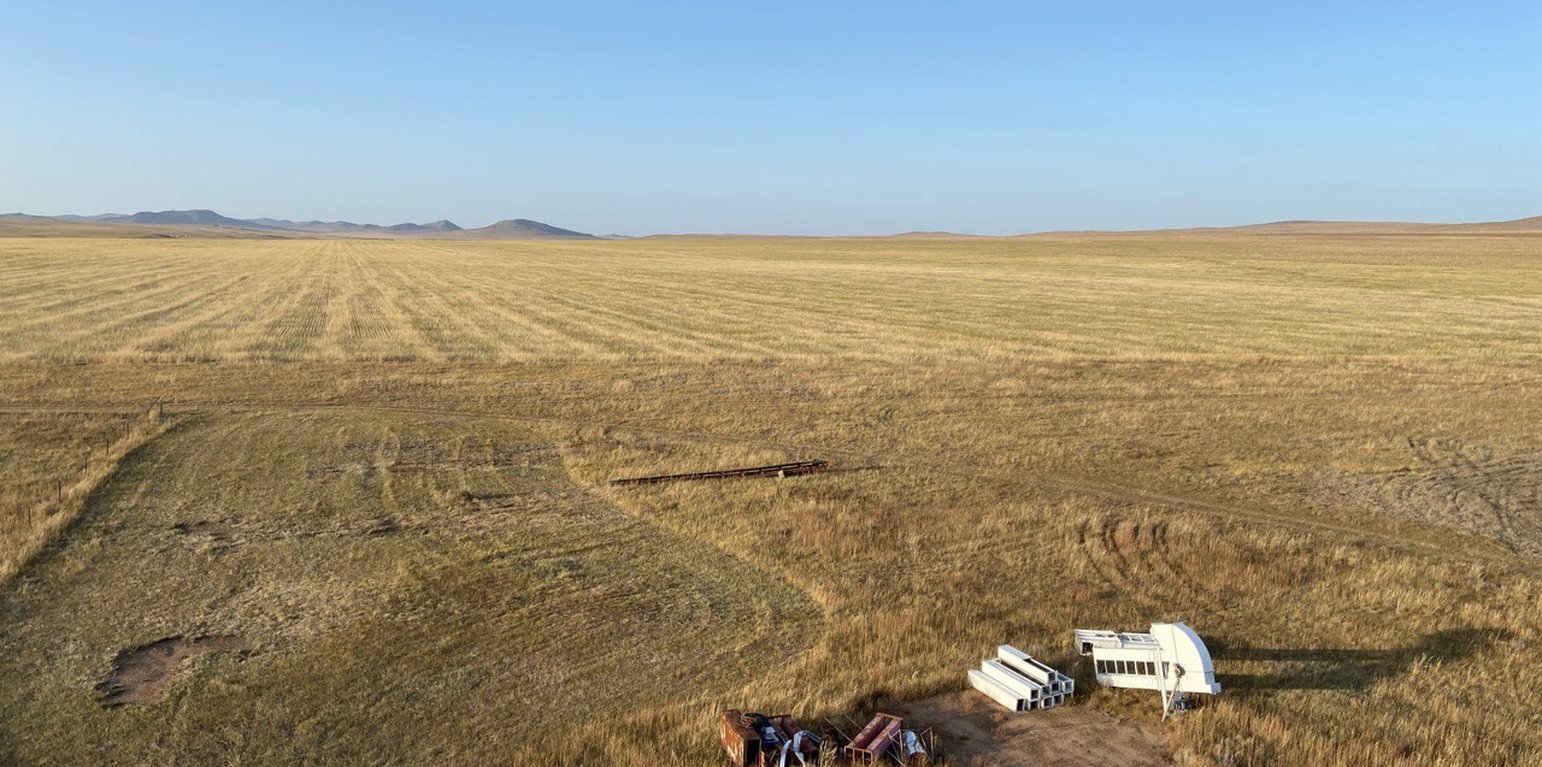



The land in Kherlen soum, Khentii province, spanning 500 hectares, was used for crop production and later for producing fodder for livestock. However, since 1984, it has been left abandoned. To rehabilitate the area and revive cropland, conservation agriculture combined with mixed cropping was introduced in 2014.
Mixed cropping encompasses various agrotechnical practices that involve the cultivation of different crops together, making use of their ability to interact with each other. The aim is to sustain crop yield in regions with limited moisture, protect the soil surface, regulate soil moisture levels, and enhance the availability of micro and macro-nutrients. In Kherlen soum, Khentii province, mixed cropping was implemented by planting seed mixtures of different proportions, taking into consideration the specific requirements and differences among various crops. Presently, annual crops such as mustard, peas, Cape rice, and wheat, rye along with rapeseeds, are successfully cultivated mixed and/or in rotation in the area.
Conservation agriculture in soil protection agriculture offers several advantages, including the enhancement of soil, its resilience to external factors such as erosion by wind, regulation of soil fertility and microorganism populations, avoidance of highly toxic substances in agriculture, and increased productivity. One significant aspect of conservation agriculture is using no-till and direct sowing techniques to minimize soil disturbance. During harvesting, only the crop heads are collected, while the remaining rootsystems and stems are left in and above the soil contributing to increasing soil organic matter. Other residues and parts of plants, such as straw/ stalks and leaves, are shredded and spread across the field to reduce soil moisture evaporation and protect it from the sun and wind. Soil erosion by wind can be mitigated by covering the soil as much and long as possible either by leaving the crop residues on the soil and/or including cover crops into crop rotations. Furthermore, this technology improves the soil health and microenvironment/ microclimate.
To initiate and implement this technology, the land user leased most of his land through a proposal, aimed at improving the soil quality of abandoned land, to the local government, and also purchased a certain amount of land through a land auction announced on the government website. Initial preparation of land for sowing consisted of removing stones from the field and spraying herbicides to get rid of weeds and their seeds. A minimal dose of herbicides with low toxicity is used to control the growth and spread of weed plants commonly found in abandoned fields. Later on mustard was incorporated into mixed cropping and rotations suppressing the growth of weed.
In the first year, the farmer planted a mixture of mustard, oilseed rape and lucerne to enhance soil penetration and break up compacted soil, as well as wheat in a 40 cm strip on stony soil with low fertility. First few years 2014-2018), the farmer didn’t harvest all the yields to keep the soil covered and improve the soil quality.
In 2019 the farmer built a fence to protect against grazing and yields significantly improved. Moreover, various equipment such as direct seeder for no till or minimum tillage crop cultivation, combine harvester, tractor, herbicide spraying machine and seed sorting machines to improve the quality of produce for the market (clean and separate seeds of different sizes and different types of crops) were bought with a bank loan.
A comprehensive knowledge of the interactions and symbiotic relationships between different crops is also essential to plan for crop mixtures and rotations. Crop morphology such as root system, competition for nutrients and water should be considered. Mustard-pea mixture facilitates harvesting as pea is difficult to harvest in monoculture and mustard can provide biological weed control.
He divided the land / field into 12 plots, which were planted with different crop mixtures and in rotation, maintaining soil fertility, limiting pests and diseases, and increasing crop yields. Legumes can improve soil fertility by adding nitrogen to the soil. The farmer practiced five-field rotation in his cropland using legumes including pea, bean, lentils and alfalfa. The rotation plan depends on climate conditions.
The levels of potassium and phosphorous in the soil were monitored and regularly measured. Only when a deficit occurred the land user used mineral fertilizers.
According to farmers who practice conservation agriculture and mixed farming, these technologies effectively maintains soil stability, ensuring its long-term sustainability.
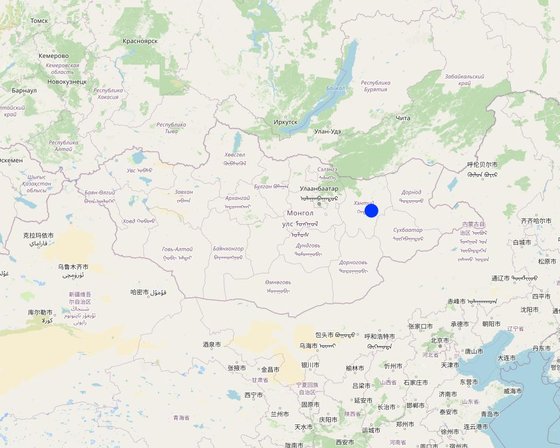
Location: Kherlen soum, Takhilgat bag, Khentii province, Mongolia
No. of Technology sites analysed: single site
Spread of the Technology: evenly spread over an area (8.0 km²)
In a permanently protected area?: No
Date of implementation: 2014; less than 10 years ago (recently)
Type of introduction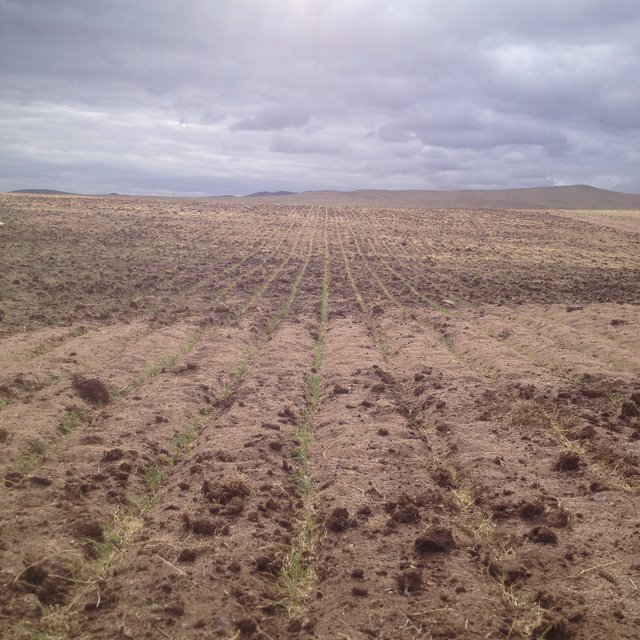
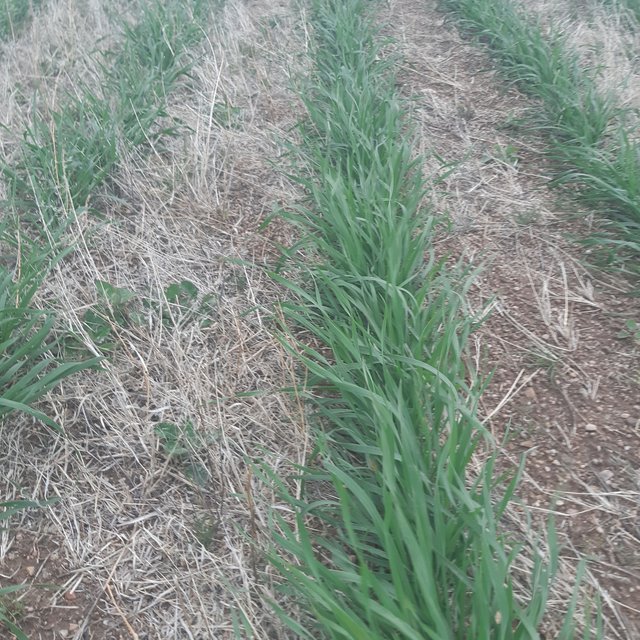






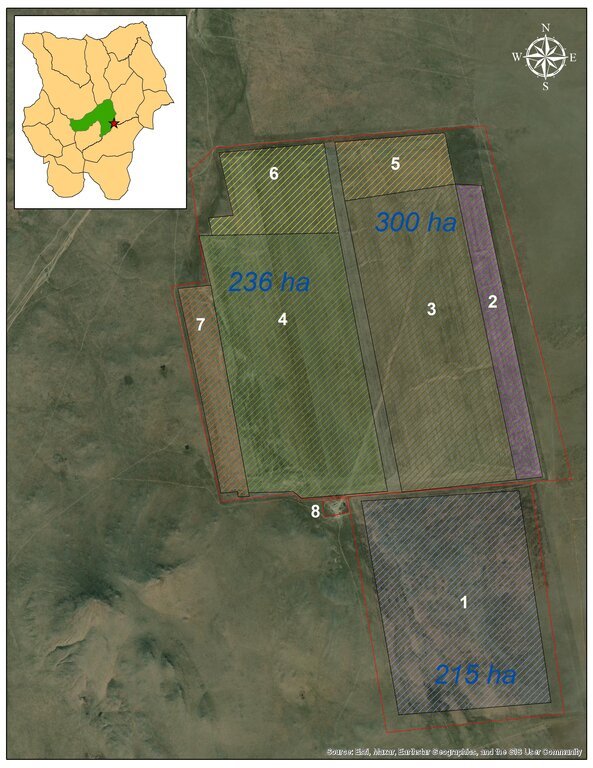
| Specify input | Unit | Quantity | Costs per Unit (Tugrik) | Total costs per input (Tugrik) | % of costs borne by land users |
| Labour | |||||
| Build fence | person | 2.0 | 15000000.0 | 30000000.0 | 100.0 |
| Spray herbicide | person | 2.0 | 350000.0 | 700000.0 | 100.0 |
| Sowing | person | 1.0 | 4000000.0 | 4000000.0 | 100.0 |
| Stone picking | хүнperson | 1.0 | 4800000.0 | 4800000.0 | 100.0 |
| Equipment | |||||
| Tractor | piece | 1.0 | 220000000.0 | 220000000.0 | 100.0 |
| Direct seeder | piece | 1.0 | 224000000.0 | 224000000.0 | 100.0 |
| Combine harvester | piece | 2.0 | 397000000.0 | 794000000.0 | 100.0 |
| Agriculture spray machine | шpiece | 1.0 | 170000000.0 | 170000000.0 | 100.0 |
| Stone picker machine | piece | 1.0 | 15000000.0 | 15000000.0 | 100.0 |
| Seed cleaning machine | piece | 3.0 | 35000000.0 | 105000000.0 | 100.0 |
| Pile machine for fencing | piece | 1.0 | 6900000.0 | 6900000.0 | 100.0 |
| Silos | tonnes (holding capacity) | 700.0 | 714285.72 | 500000004.0 | 100.0 |
| Plant material | |||||
| Seeds first year | tonnes | 70.5 | 4400000.0 | 310200000.0 | 100.0 |
| Fertilizers and biocides | |||||
| Herbicide | l | 2400.0 | 8000.0 | 19200000.0 | 100.0 |
| Construction material | |||||
| Poles and net for fence | км | 25.0 | 10800000.0 | 270000000.0 | 100.0 |
| Other | |||||
| Land lease | hа | 800.0 | 500000.0 | 400000000.0 | 100.0 |
| Total costs for establishment of the Technology | 3'073'800'004.0 | ||||
| Total costs for establishment of the Technology in USD | 890'182.45 | ||||
| Specify input | Unit | Quantity | Costs per Unit (Tugrik) | Total costs per input (Tugrik) | % of costs borne by land users |
| Labour | |||||
| Spray herbicide | person | 2.0 | 1400000.0 | 2800000.0 | 100.0 |
| Harvesting | person | 4.0 | 1500000.0 | 6000000.0 | 100.0 |
| Separating seeds | person | 2.0 | 1000000.0 | 2000000.0 | 100.0 |
| Sowing seeds | person | 2.0 | 1500000.0 | 3000000.0 | 100.0 |
| Equipment | |||||
| Spraying machine (fuel) | l/year | 400.0 | 2400.0 | 960000.0 | 100.0 |
| Combine harvesting machine (fuel) | l/year | 4000.0 | 2400.0 | 9600000.0 | 100.0 |
| Sowing machine (fuel) | l/year | 4000.0 | 2400.0 | 9600000.0 | 100.0 |
| Spare parts and maintenance of machines | ha | 800.0 | 10500.0 | 8400000.0 | 100.0 |
| Plant material | |||||
| Seeds | tonne/year | 13.7 | 4400000.0 | 60280000.0 | 100.0 |
| Fertilizers and biocides | |||||
| Herbicide (different types) | l | 1.0 | 30000.0 | 30000.0 | 100.0 |
| Other | |||||
| Land use tax | MNT/year | 1.0 | 1900000.0 | 1900000.0 | 100.0 |
| Soil sampling and testing | MNT/year | 1.0 | 830000.0 | 830000.0 | 100.0 |
| Total costs for maintenance of the Technology | 105'400'000.0 | ||||
| Total costs for maintenance of the Technology in USD | 30'524.18 | ||||
Quantity before SLM: 0
Quantity after SLM: 25 centner/ha
It is important to note that crop production is highly dependent on weather conditions. In 2021, when there was enough precipitation, a yield of 25 centner/ha was achieved. However, in 2014-2016, when technology implementation was just starting in severely degraded land and coincided with drought, there were occasions where all yield was lost.
Specific weight, indicating seed quality, of grain reached 900 g/l and, gluten content of wheat always meets the requirements of first grade of food.
Comparisons between 2018 and 2022 indicate that the average length of the wheat grain head increased and reached 10 - 12 centimeters by 1st July, resulting in a higher yield. Oats and wheat are harvested for fodder production while peas are supplied to chicken farms.
In terms of wheat quality, it is classified into first grade. The protein content of Bayalag variety of peas is 18-20%, starch content is 26-35%.
We concluded that this technology can overcome any risks related to labor and expenses, because sowing time is different for many types of crops, reducing the amount of expenses and labor load.
Quantity before SLM: 1
Quantity after SLM: 20
About 20 species of plants are being cultivated.
Quantity before SLM: 9 centner
Quantity after SLM: 3 centner
The amount of seeds used for planting is lower, the seeds can be used for the next year cultivation: The spread of plant diseases / pests and use of pesticides is relatively low. Herbizides and fertilizers are not applied in this technology. Thus, there is no expense on that.
Quantity before SLM: None
Quantity after SLM: 5 centner
The yield is dependent on the climatic conditions of the year. In wheat yield, 3 centners were spent on sowing and 5 centners were obtained for each hectare when the weather was not favorable and precipitation was relatively low. Therefore, the net income is 2 centners in this case.
Quantity before SLM: 4
Quantity after SLM: 2
Sowing time is different for many types of crops, so it does not requires a high number of labor. 2 persons typically work on the entire area throughout the year and, 2 more persons are employed during harvesting.
Mentorship program for other farmers is organized.
Due to cover crops and residue left on the soil, it reduces the amount of water evaporation from the soil and keeps the soil moisture .
Cover crops and plant residues left on the soil surface protect against wind erosion, reduces soil water evaporation and improves soil moisture content.
Quantity before SLM: 0 см
Quantity after SLM: 2 см
Технологи хэрэгжүүлэхээс өмнө тус талбайд ургамал сийрэг тархсан, өнгөн хөрс салхиар хүчтэй элэгдэж үржил шимээ алдсан, хайргаар битүү хучигдсан байсан.
Snow cover in winter, has an important effect on protecting the soil from wind erosion in the spring.
It is believed that when the content of organic matter in the soil increases by 1 percent, the water holding capacity of the soil increases by 4 percent. From this point of view, it can be concluded that the content of organic matter has improved.
Before the technology, vegetation cover was sparse and there were only 2-3 species of weeds in a square of 1m x 1m.
Aboveground biomass increased. Prairie sagebrush is predominating in natural vegetation community.
According to the results of soil sampling, the ratio of microorganisms in the soil has increased. It is also clearly observed that the variety of insects and the birds that feed on them have increased due to the rise in plant species.
From 2019, mushrooms started growing in the field. Flaxes, forming symbioses with fungus, are planted in order to enhance distribution of fungus in soil. Fungus has a positive effect on soil quality.
Mustard and peas have been observed to limit the growth of weeds such as hogweed. Additionally, mustard releases two powerful substances that can help limit the spread of diseases.
Quantity before SLM: high
Quantity after SLM: low
Sown stands and plant cover can mitigate heavy flooding, then, the risk of washing away the fertile layer of the soil can be reduced. In addition, the stands will retain plant residues and other objects carried by the flood water. It can also be composted into the soil.
Quantity before SLM: high
Quantity after SLM: low
Because the soil moisture content is good compared to other areas, the yield is higher in drought years and soil erosion is less.
Wind velocity is high in this region. We are thinking about establishing windbreak in the field.
Improves wind cleanliness by catching organic material and other residues carried by the wind.
The technology can reduce the risk of flooding